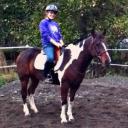Yahoo Answers is shutting down on May 4th, 2021 (Eastern Time) and beginning April 20th, 2021 (Eastern Time) the Yahoo Answers website will be in read-only mode. There will be no changes to other Yahoo properties or services, or your Yahoo account. You can find more information about the Yahoo Answers shutdown and how to download your data on this help page.
Trending News
What are the differences in the different types of hay?
I've only ever leased horses, and at my barn, the hay is included in the board, so I don't know much about it. I've heard of grass hay, Timothy hay, and alfalfa hay, but are there more? What's the difference, besides their obvious appearance and texture? What's the difference in nutritional value?
Thanks!
8 Answers
- gallopLv 710 years agoFavorite Answer
The major difference is between grass hays and legume hays. Alfalfa, lucerne, and clover hays are all legumes. virtually all of the others are grasses. Most grass hays are safe to feed 24/7 free choice, where legumes are too high or out of balance in some minerals and protein to be fed that way. There are numerous types of grass hay, and depending on where you live and what is grown there, some will be available and some won't. Coastal hay is not available in the midwest, for example.
Here is an article with good information on various hays.........................
http://www.uky.edu/Ag/AnimalSciences/pubs/id146.pd...
Safergrass.org is a good site for information, but the site has been hacked so you can't access it right now.
***********************************
Add.......................... Which cutting your hay is from (1st, 2nd, 3rd, and this year we got a 4th cutting from our fields) is not as significant as many people think it is. All of our cuttings are good quality hay.
What is most vital to the nutrient values and quality of the hay is the stage of growth the grasses or legumes are in at the time when the hay is cut, regardless of which cutting it is. A legume like alfalfa, for example, can vary from 14% protein to well over 20% protein, depending on the stage of growth it is in when cut, and that is true of the alfalfa regardless of whether it is the 1st, 2nd, 3rd, and 4th cutting.
Also, when looking to create a low fructan hay for laminitic and insulin resistant horses, the time of day it is cut can make a significant difference in the percentage of fructans stored in the hay, with nightime cutting after 3 am and before 10 am being the ideal time. There are also differences in fructan levels from one month to the next so that levels in a second cutting may be lower than in the first and third.
Source(s): Registered Nurse and 58 years with horses We grow alfalfa and grass mix hays - AtracitaLv 610 years ago
There are tons of different types of hay; it all depends where the grass
was cut, when the grass was cut and what kind of nutrition the grass had
before it was hay.
There are other types- Orchid Hay, 1st Cut, Second Cut, Third, Fourth etc.
(Some other types can be available but it depends on what area it came
from.)
Grass hay is more fine and usually has a higher nutritional value than
something more yellow like 1st cut. Grass hay is usually free grown and
cut before any heads are shown. It isn't always the best option to buy
because it is lighter in weight and horses can go through it more.
Timothy hay is usually more local and has some coarseness to it; usually
almost like a 1st/2nd cut with higher nutrition than yellow hay or something
like 1st cut with low nutrition. There is a good amount of leaf, some heads
and there can be a fine/coarse mixture in the hay depending on your area.
Timothy "grass" is actually a type of grass that is very green (almost like
an alfalfa type hay.)
Alfalfa hay is usually the heaviest, most leafy and most "smelly" (in a good
way) type of hay. This usually has the highest nutritional value and is grown
with regular grass and seed. Alfalfa is usually more expensive because of
how heavy it is and you don't usually have to feed as much. This type of
hay can have more sugar content than regular types of hay and contains
a mixture of grass, leafy stuff and course stuff. It is a really good combination.
I usually go for late Timothy, heavy 1st cut or a coarse 2nd cut. Buying super green,
light and fine hay doesn't last long in the horse's system and you may end up
having to buy more. Most people use fine green hay during the summer and
use a coarser hay in the winter (coarse hay can stay longer in horses' systems.)
For buying hay, you have to go by color, weight & texture.
You always look for leaf (leaves) and a nice green color with some weight.
If you feel the hay and it pokes you instead of being super soft, this is coarser hay.
It is best to have a mixture of coarse/soft hay.
Never buy anything with weeds or heads (heads are those brown oval shaped
pieces that grow on the hay when it is cut too late, this lowers nutritional value.)
Source(s): I used to judge hay (won each time) & I buy it. - 10 years ago
That is a way more complicated question than it sounds like, LOL! I've been working really hard this summer to understand this stuff myself. I think it can really vary from region to region - for instance, I just found out what "2nd cut" means here in Alberta and why I don't want it....I always assumed it was "less rich" but it turns out it is the opposite. My new hay guy (who, by the way, is like a 24 year old kid, but is WAY better than my old hay guy, who SHOULD have had tons of experience) explained that here in Alberta with our cooler climate, the 1st cut contains lots of grass and not nearly as much alfalfa, but by the time a second cut is done, most of the grass has stopped growing, but the alfalfa (which grows in cooler temps) has taken over. Therefore, most second cut hay is mainly alfalfa, which is NOT something you'd feed too much of (like gallop said). Make sense? But I don't know if the same would be true in a warm climate where grass grows for a longer time.
- How do you think about the answers? You can sign in to vote the answer.
- 5 years ago
Thrush: It usually does smell pretty bad. I guess it depends on how good a person's sense of smell is. The sole (usually in the commisures or the central sulcus) is most often sort of gooey or smushy and blackish, foul smelling. You can clean your horse's hooves well, including the commisures and the central sulcus and pour on a mild bleach solution, if you suspect thrush. Hay: best hay depends on your horse, his physical condition, any underlying health issues and what kind of work he does for a living. Generally speaking, the best hay is a grass mix. Timothy, orchard, coastal (if your horse is ok with it). Alfalfa has a higher protein content, as does peanut hay and other legumes. Most horses don't need it and some will develop problems if fed it, or fed too much of it. Stick to good quality grass hay and you'll be safe. Introducing new feed types: Do this gradually. For instance, if your horse is getting 1 lb of feed X morning and night, and you want to switch to feed Y, start feeding him 3/4 lb feed X and 1/4 lb feed Y and do this for about 4 days to a week. Second week or so, feed 1/2 lb feed X and 1/2 lb feed Y, for a week. Week 3, 1/4 lb feed X, 3/4 lb feed Y. You get the idea. This is very conservative - some horses are more sensitive to feed changes than are others. The horse's digestive system has to be given time to develop the specific bacterial flora appropriate to the new feed, and that takes time, This is why feed changes for horses are done gradually. Best things to do to help forestall colic are to make sure your horse has access to FRESH CLEAN water at all times. 2 buckets hung in the stall, 2 water troughs outside, kept clean. Add a tablespoon of salt to his feed to encourage him to drink water. Always thoroughly inspect your hay and grain for any moulds or other growths and foreign matter. Get to know your new horse's personality and habits, so that you can immediately spot when he's acting a little bit funny. You should know the signs of colic. If you don't get yourself a good horse-owners' vet book and start reading it. Hopefully you already did this before getting your new horse. There's so much to know, and as a horse owner, it's your responsibility to know it.
- british_srt_4Lv 410 years ago
You got the basics. At the end of the day I would consider 'grass' hay, hay from a meadow in that region..... all hay is grass hay as hay is dried grass, so its a name for native and wild grasses from a regional meadow. Alfalfa is a richer product, a more nutritional hay with higher quanities of nutrients and protein. People with hard keepers or show horses tend to feed more alfalfa. Timothy as long as it isn't too course and stalking is also a good hay to feed. Grass/meadow hay tends to be softer a mix of different grasses. Some horses do have intolerances towards the various hays available, if your horse has the "squirts" it maybe necessary to try a different hay type. There are hay substitutions, hay cubes usually consist of alfalfa and timothy hay. They need to be soaked thoroughly but are good for horses with dust allergies. Dengi is a chopped timothy with molasses or soy. Again a good product for horses with dust allergies. If hay has to be substituted, you need to feed alot of cubes or dengi
Source(s): Equine vet tech - 6 years ago
This Site Might Help You.
RE:
What are the differences in the different types of hay?
I've only ever leased horses, and at my barn, the hay is included in the board, so I don't know much about it. I've heard of grass hay, Timothy hay, and alfalfa hay, but are there more? What's the difference, besides their obvious appearance and texture? What's the difference in...
Source(s): differences types hay: https://shortly.im/tPKGS







